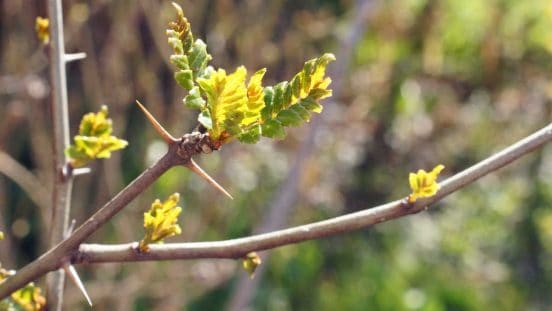My sansho (Japanese pepper, Zanthoxylum piperitum) is now in its third year, after its second winter…
This Is Sansho
By now, my research into the topic has progressed to the point where I can tell that these plants really are sansho (rather than another kind of Zanthoxylum, especially the ones used for huajiao, i.e. Sichuan pepper).
I have grown them from seeds I got from Japan, admittedly, so they should be Zanthoxylum piperitum, the Japanese pepper, sansho.
You may think that this should be easy to tell, but botanical mis-classifications are still going around a lot; Sichuan pepper “corns” are still often traded as Z. piperitum. Except, as it turns out, they cannot be from that species.

Species and Uses
On the other hand, kinome (young sansho shoots) and, perhaps to a lesser extent, sansho hana and sansho no mi (flowers and young “corns” of sansho, respectively), cannot be from a Sichuan pepper.
Sure, there are reports that Sichuan pepper leaves are sometimes eaten in China, as well, but the use of young sansho leaves and flowers and young fruit in Japan makes a lot more sense when seeing Z. piperitum.

It just appears to grow rather less prickly, more delicately, when young. And its aroma is rather finer, too.
Growth and Winter Temperatures
For the first winter, I kept the sansho plants in pots and brought them into a cold (but not-freezing) place. I was told that the plants do not get frost where they (at least, the ones I got the seeds from) grow in Japan, so I wanted to be careful.
They got through that first winter quite alright; the main issue was that, by the time I was wondering if they did (when there was still frost outside), they already developed leaves again.
Last winter, I left the plants outside. Some of them are in a raised bed, others in a small greenhouse (in the ground of that), a few in pots I left in greenhouses. All of them had actually had issues during last year’s growing season; I was not there to take care of them, and they did not always get as much water as they should have. (Admittedly, that usually happens – and did happen – even when I was still around; I’m not much of a plant-waterer.)
The winter was very mild; the sansho plants again came back rather too soon.
Unsurprisingly, they came back sooner and quicker in the greenhouses than outdoors.

Frost Sensitivity
This spring has been yet another peculiar one, with temperatures rather too warm soon, followed by frost nights.
The two sansho outside in a raised bed got caught by that. One of them was already further along the new budding of the leaves, and all the buds froze in the frost.
The second plant, close by, was slower to come, but had developing leaf buds – and those also fell victim to the frost.
The sansho really seems to be sensitive – but then again, this frost after warm (to hot) days caused issues for other plants, as well.
Andaliman Pepper and Winter
This included the Andaliman pepper (Zanthoxylum acanthopodium) which is Southeast Asian, and keeps its leaves through the winter.
They just dry out a bit, then come back with the rising temperatures. Its fresh growth was also destroyed by the frost, though.

Re-Growth after Frost
All the plants came back with new buds taking over, though.

Incidentally, this also makes me more willing to “risk” taking off some kinome (young shoots) to try them in cooking; the sansho seems to be quite well-growing now that it’s better cared for and more established.
Onwards.
One of the young sansho plants also decided to flower already… which made it clear that that particular plant is a male, and that this sansho is dioecious.
That’s going to make things interesting. If I only had males, things wouldn’t work out for fruits and seeds.

Next up, I am getting additional plants that a gardener in Germany has offered (of Z. piperitum, Z. schinifolium – Korean Pepper, and Z. americanum) – and of course, some attempts at germinating seeds from China are ongoing (but not looking good).

Leave a Reply
You must be logged in to post a comment.